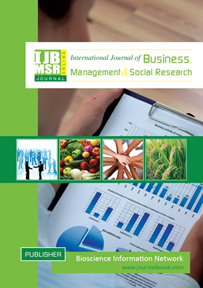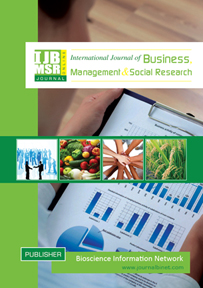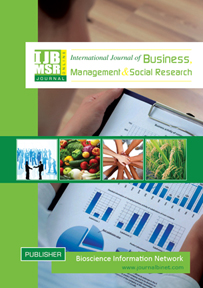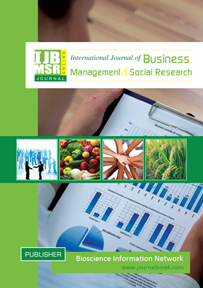International Journal of Business Management and Social Research
Volume 12, Issue 01 | Year of publication: 2023
Article Type: Survey paper | No. 66, 2023 | Country: Bangladesh | pp. 619-626 | Open Access
Title: Female worker in fish processing industry: a study on Atlas Seafood Industry Ltd., Khulna, Bangladesh
Author: Pervin, S., Basak, B. K., Islam, S. and Hossain, M. M.
DOI: http://dx.doi.org/10.18801/ijbmsr.120123.66
Title: Female worker in fish processing industry: a study on Atlas Seafood Industry Ltd., Khulna, Bangladesh
Author: Pervin, S., Basak, B. K., Islam, S. and Hossain, M. M.
DOI: http://dx.doi.org/10.18801/ijbmsr.120123.66
Title: Female worker in fish processing industry: a study on Atlas Seafood Industry Ltd., Khulna, Bangladesh
Abstract
This study was undertaken to determine the livelihood status of female workers of Atlas Seafood Industry Ltd., Khulna, Bangladesh, from July to December, 2022. The data were collected through the questionnaire, survey, group discussion and public interview. The present study provides a clear-cut picture of the female workers in Atlas Sea Food Industry Ltd. The study's results revealed some interesting facts and showed that most involved females are in 16-30 years age group, whereas most were Muslim (90%). About 75% of workers were illiterate and 24% were literate. It was found that 61% of house were Kacha (Made of mud and straw) while 37% of house were Semi-pucca (Tin shed buildings) and only 2% of house were pucca. (Bricks Built house). The major constraints were the lack of proper knowledge and illiteracy, not as much governmental support. The result found that 60.83% of female workers joined the fish processing industry without their husbands, 23.33% absence of father, 11.67% absence of legal guardian and 4.17% others, respectively. Most of the female (72.5%) were found to work at lower levels, while only 1.67% worked on higher level jobs in the industry and this portion were permanent workers. The weekly salary system is only for temporary workers whose income ranges between Tk.600 to 3000 per week while the permanent workers receive their monthly salary income between Tk.12000 to 20000 per month.
Key Words: Livelihood status, Female workers, Atlas Seafood Industry Ltd.
Abstract
This study was undertaken to determine the livelihood status of female workers of Atlas Seafood Industry Ltd., Khulna, Bangladesh, from July to December, 2022. The data were collected through the questionnaire, survey, group discussion and public interview. The present study provides a clear-cut picture of the female workers in Atlas Sea Food Industry Ltd. The study's results revealed some interesting facts and showed that most involved females are in 16-30 years age group, whereas most were Muslim (90%). About 75% of workers were illiterate and 24% were literate. It was found that 61% of house were Kacha (Made of mud and straw) while 37% of house were Semi-pucca (Tin shed buildings) and only 2% of house were pucca. (Bricks Built house). The major constraints were the lack of proper knowledge and illiteracy, not as much governmental support. The result found that 60.83% of female workers joined the fish processing industry without their husbands, 23.33% absence of father, 11.67% absence of legal guardian and 4.17% others, respectively. Most of the female (72.5%) were found to work at lower levels, while only 1.67% worked on higher level jobs in the industry and this portion were permanent workers. The weekly salary system is only for temporary workers whose income ranges between Tk.600 to 3000 per week while the permanent workers receive their monthly salary income between Tk.12000 to 20000 per month.
Key Words: Livelihood status, Female workers, Atlas Seafood Industry Ltd.
HOW TO CITE THIS ARTICLE:
MLA
Pervin, S. et al. “Female worker in fish processing industry: a study on Atlas Seafood Industry Ltd., Khulna, Bangladesh”. International Journal of Business, Management and Social Research 12(01) (2023): 619-626.
APA
Pervin, S., Basak, B. K., Islam, S. and Hossain, M. M. (2023). Female worker in fish processing industry: a study on Atlas Seafood Industry Ltd., Khulna, Bangladesh. International Journal of Business, Management and Social Research, 12(01), 619-626.
Chicago
Pervin, S., Basak, B. K., Islam, S. and Hossain, M. M. “Female worker in fish processing industry: a study on Atlas Seafood Industry Ltd., Khulna, Bangladesh”. International Journal of Business, Management and Social Research, 12(01) (2023): 619-626.
Harvard
Pervin, S., Basak, B. K., Islam, S. and Hossain, M. M. 2023. Female worker in fish processing industry: a study on Atlas Seafood Industry Ltd., Khulna, Bangladesh. International Journal of Business, Management and Social Research, 12(01) pp. 619-626.
Vancouver
Pervin, S, Basak, BK, Islam, S and Hossain, MM. Female worker in fish processing industry: a study on Atlas Seafood Industry Ltd., Khulna, Bangladesh. International Journal of Business, Management and Social Research. 2023 July, 12(01), 619-626.
MLA
Pervin, S. et al. “Female worker in fish processing industry: a study on Atlas Seafood Industry Ltd., Khulna, Bangladesh”. International Journal of Business, Management and Social Research 12(01) (2023): 619-626.
APA
Pervin, S., Basak, B. K., Islam, S. and Hossain, M. M. (2023). Female worker in fish processing industry: a study on Atlas Seafood Industry Ltd., Khulna, Bangladesh. International Journal of Business, Management and Social Research, 12(01), 619-626.
Chicago
Pervin, S., Basak, B. K., Islam, S. and Hossain, M. M. “Female worker in fish processing industry: a study on Atlas Seafood Industry Ltd., Khulna, Bangladesh”. International Journal of Business, Management and Social Research, 12(01) (2023): 619-626.
Harvard
Pervin, S., Basak, B. K., Islam, S. and Hossain, M. M. 2023. Female worker in fish processing industry: a study on Atlas Seafood Industry Ltd., Khulna, Bangladesh. International Journal of Business, Management and Social Research, 12(01) pp. 619-626.
Vancouver
Pervin, S, Basak, BK, Islam, S and Hossain, MM. Female worker in fish processing industry: a study on Atlas Seafood Industry Ltd., Khulna, Bangladesh. International Journal of Business, Management and Social Research. 2023 July, 12(01), 619-626.
Article Type: Survey paper | No. 67, 2023 | Country: Bangladesh | pp. 627-633 | Open Access
Title: Fish species availability with their prices in fish markets of Khulna district in Bangladesh
Author: Azad, K. N., Sakib, M. N. and Azad, K. N.
DOI: http://dx.doi.org/10.18801/ijbmsr.120123.67
Title: Fish species availability with their prices in fish markets of Khulna district in Bangladesh
Author: Azad, K. N., Sakib, M. N. and Azad, K. N.
DOI: http://dx.doi.org/10.18801/ijbmsr.120123.67
Fish species availability with their prices in fish markets of Khulna district in Bangladesh
Abstract
The present study was conducted to identify the available fish species, average fish price, and marketing system in five fish markets in Khulna district of Bangladesh. A total of 40 fish retailers were interviewed through a questionnaire survey for the collection of data. The results showed that freshwater species were dominant in the markets. Some marine and brackish water species were also abundant. According to the survey, kakila, khalisha, sarpunti, suri, shal baim, and koi were relatively less available, whereas boal, pabda and ayre were very rarely found. The lower priced fish were silver carp, pangas, tilapia, mrigal, suri, etc. whereas the price of ayre, vetki, bhangon, shing, magur, ilish, and golda chingri were higher. When ilish were abundant in markets, the price of other fish declined. Intermediaries such as wholesalers and retailers were involved in selling fish from fishers or fish farmers to the consumers. Fish were mostly carried to the markets through rickshaws, vans, easy bikes, etc. and sometimes the fish traders brought fish from distant places by larger vehicles like pick-ups, trucks, the roofs of buses, etc. The fish retailers faced some problems including higher transport costs, poor market infrastructures, inadequate drainage systems, poor water supply, unhygienic conditions, lack of storage facilities, lack of marketing facilities, etc. Therefore, fish market infrastructures should be improved with proper sanitation, hygienic condition, drainage as well as washing facilities and fish marketing channels need to be developed by establishing modern wholesaling facilities with the support of government or NGOs.
Key Words: Fish market, marketing system, Fish species, Fish price, Khulna
Abstract
The present study was conducted to identify the available fish species, average fish price, and marketing system in five fish markets in Khulna district of Bangladesh. A total of 40 fish retailers were interviewed through a questionnaire survey for the collection of data. The results showed that freshwater species were dominant in the markets. Some marine and brackish water species were also abundant. According to the survey, kakila, khalisha, sarpunti, suri, shal baim, and koi were relatively less available, whereas boal, pabda and ayre were very rarely found. The lower priced fish were silver carp, pangas, tilapia, mrigal, suri, etc. whereas the price of ayre, vetki, bhangon, shing, magur, ilish, and golda chingri were higher. When ilish were abundant in markets, the price of other fish declined. Intermediaries such as wholesalers and retailers were involved in selling fish from fishers or fish farmers to the consumers. Fish were mostly carried to the markets through rickshaws, vans, easy bikes, etc. and sometimes the fish traders brought fish from distant places by larger vehicles like pick-ups, trucks, the roofs of buses, etc. The fish retailers faced some problems including higher transport costs, poor market infrastructures, inadequate drainage systems, poor water supply, unhygienic conditions, lack of storage facilities, lack of marketing facilities, etc. Therefore, fish market infrastructures should be improved with proper sanitation, hygienic condition, drainage as well as washing facilities and fish marketing channels need to be developed by establishing modern wholesaling facilities with the support of government or NGOs.
Key Words: Fish market, marketing system, Fish species, Fish price, Khulna
HOW TO CITE THIS ARTICLE:
MLA
Azad, K. N. et al. “Fish species availability with their prices in fish markets of Khulna district in Bangladesh”. International Journal of Business, Management and Social Research 12(01) (2023): 627-633.
APA
Azad, K. N., Sakib, M. N. and Azad, K. N. (2023). Fish species availability with their prices in fish markets of Khulna district in Bangladesh. International Journal of Business, Management and Social Research, 12(01), 627-633.
Chicago
Azad, K. N., Sakib, M. N. and Azad, K. N. “Fish species availability with their prices in fish markets of Khulna district in Bangladesh”. International Journal of Business, Management and Social Research, 12(01) (2023): 627-633.
Harvard
Azad, K. N., Sakib, M. N. and Azad, K. N. 2023. Fish species availability with their prices in fish markets of Khulna district in Bangladesh. International Journal of Business, Management and Social Research, 12(01) pp. 627-633.
Vancouver
Azad, KN, Sakib, MN, and Azad, KN. Fish species availability with their prices in fish markets of Khulna district in Bangladesh. International Journal of Business, Management and Social Research. 2023 December, 12(01), 627-633.
MLA
Azad, K. N. et al. “Fish species availability with their prices in fish markets of Khulna district in Bangladesh”. International Journal of Business, Management and Social Research 12(01) (2023): 627-633.
APA
Azad, K. N., Sakib, M. N. and Azad, K. N. (2023). Fish species availability with their prices in fish markets of Khulna district in Bangladesh. International Journal of Business, Management and Social Research, 12(01), 627-633.
Chicago
Azad, K. N., Sakib, M. N. and Azad, K. N. “Fish species availability with their prices in fish markets of Khulna district in Bangladesh”. International Journal of Business, Management and Social Research, 12(01) (2023): 627-633.
Harvard
Azad, K. N., Sakib, M. N. and Azad, K. N. 2023. Fish species availability with their prices in fish markets of Khulna district in Bangladesh. International Journal of Business, Management and Social Research, 12(01) pp. 627-633.
Vancouver
Azad, KN, Sakib, MN, and Azad, KN. Fish species availability with their prices in fish markets of Khulna district in Bangladesh. International Journal of Business, Management and Social Research. 2023 December, 12(01), 627-633.
Article Type: Survey paper | No. 68, 2023 | Country: Bangladesh | pp. 634-641 | Open Access
Title: Linking lives and livelihoods: Social ties and business performance among fish farmers in Bangladesh
Author: Ahmed, M. I., Zabir, A. A., Haque, F., Talukdar, M. M. and Rahman, M. M.
DOI: http://dx.doi.org/10.18801/ijbmsr.120123.68
Title: Linking lives and livelihoods: Social ties and business performance among fish farmers in Bangladesh
Author: Ahmed, M. I., Zabir, A. A., Haque, F., Talukdar, M. M. and Rahman, M. M.
DOI: http://dx.doi.org/10.18801/ijbmsr.120123.68
Linking lives and livelihoods: Social ties and business performance among fish farmers in Bangladesh
Abstract
Social capital is a crucial commodity that has significant consequences for improving business results. This study examines the relationship between social capital and the business performance of fish farmers in Bangladesh. The research systematically examines the social relationships among fish farmers, such as bonding, bridging, and linking ties, to understand how these ties impact business performance. The study examines social capital determinants against business success measures by analyzing data from 320 fish farmers in Mymensingh and Bogura districts using descriptive analysis, correlation tests, and hierarchical multiple regression. Structured face-to-face interviews aided in data collecting. Results from hierarchical multiple regression analysis show that increased access to loans, training, and physical capital has a beneficial impact on business performance. The study indicates that establishing bonding, bridging, and linking ties might enhance the commercial success of fish farmers. However, it also highlights a subtle aspect: a stronger connection may have a negative effect on business results. Ultimately, this study recommends that fish farmers should utilize various social ties while being careful to minimize the negative impacts of strong ties. An in-depth comprehension of the nature of social ties offers useful insights for fish farmers to enhance their social capital and ultimately improve company success.
Key Words: Social capital, Fish producers, Business performance, Fish farming, Bonding ties, Bridging ties and Linking ties.
Abstract
Social capital is a crucial commodity that has significant consequences for improving business results. This study examines the relationship between social capital and the business performance of fish farmers in Bangladesh. The research systematically examines the social relationships among fish farmers, such as bonding, bridging, and linking ties, to understand how these ties impact business performance. The study examines social capital determinants against business success measures by analyzing data from 320 fish farmers in Mymensingh and Bogura districts using descriptive analysis, correlation tests, and hierarchical multiple regression. Structured face-to-face interviews aided in data collecting. Results from hierarchical multiple regression analysis show that increased access to loans, training, and physical capital has a beneficial impact on business performance. The study indicates that establishing bonding, bridging, and linking ties might enhance the commercial success of fish farmers. However, it also highlights a subtle aspect: a stronger connection may have a negative effect on business results. Ultimately, this study recommends that fish farmers should utilize various social ties while being careful to minimize the negative impacts of strong ties. An in-depth comprehension of the nature of social ties offers useful insights for fish farmers to enhance their social capital and ultimately improve company success.
Key Words: Social capital, Fish producers, Business performance, Fish farming, Bonding ties, Bridging ties and Linking ties.
HOW TO CITE THIS ARTICLE?
MLA
Ahmed, M. I. et al. “Linking Lives and Livelihoods: Social Ties and Business Performance among Fish Farmers in Bangladesh”. International Journal of Business, Management and Social Research 12(01) (2023): 634-641.
APA
Ahmed, M. I., Zabir, A. A., Haque, F., Talukdar, M. M. and Rahman, M. M. (2023). Linking Lives and Livelihoods: Social Ties and Business Performance among Fish Farmers in Bangladesh. International Journal of Business, Management and Social Research, 12(01), 634-641.
Chicago
Ahmed, M. I., Zabir, A. A., Haque, F., Talukdar, M. M. and Rahman, M. M. “Linking Lives and Livelihoods: Social Ties and Business Performance among Fish Farmers in Bangladesh”. International Journal of Business, Management and Social Research, 12(01) (2023): 634-641.
Harvard
Ahmed, M. I., Zabir, A. A., Haque, F., Talukdar, M. M. and Rahman, M. M. 2023. Linking Lives and Livelihoods: Social Ties and Business Performance among Fish Farmers in Bangladesh. International Journal of Business, Management and Social Research, 12(01) pp. 634-641.
Vancouver
Ahmed, MI, Zabir, AA, Haque, F, Talukdar, MM and Rahman, MM. Linking Lives and Livelihoods: Social Ties and Business Performance among Fish Farmers in Bangladesh. International Journal of Business, Management and Social Research. 2023 December, 12(01), 634-641.
MLA
Ahmed, M. I. et al. “Linking Lives and Livelihoods: Social Ties and Business Performance among Fish Farmers in Bangladesh”. International Journal of Business, Management and Social Research 12(01) (2023): 634-641.
APA
Ahmed, M. I., Zabir, A. A., Haque, F., Talukdar, M. M. and Rahman, M. M. (2023). Linking Lives and Livelihoods: Social Ties and Business Performance among Fish Farmers in Bangladesh. International Journal of Business, Management and Social Research, 12(01), 634-641.
Chicago
Ahmed, M. I., Zabir, A. A., Haque, F., Talukdar, M. M. and Rahman, M. M. “Linking Lives and Livelihoods: Social Ties and Business Performance among Fish Farmers in Bangladesh”. International Journal of Business, Management and Social Research, 12(01) (2023): 634-641.
Harvard
Ahmed, M. I., Zabir, A. A., Haque, F., Talukdar, M. M. and Rahman, M. M. 2023. Linking Lives and Livelihoods: Social Ties and Business Performance among Fish Farmers in Bangladesh. International Journal of Business, Management and Social Research, 12(01) pp. 634-641.
Vancouver
Ahmed, MI, Zabir, AA, Haque, F, Talukdar, MM and Rahman, MM. Linking Lives and Livelihoods: Social Ties and Business Performance among Fish Farmers in Bangladesh. International Journal of Business, Management and Social Research. 2023 December, 12(01), 634-641.
Volume 12, Issue 02 | Year of publication: 2023
Article Type: Survey paper | No. 69, 2023 | Country: Bangladesh | pp. 642-646 | Open Access
Title: Navigating networks: Exploring the social ties among fish farmers in Bangladesh
Author: Ahmed, M. I., Talukdar, M. M., Haque, F., Rahman, M. M., and Tonny, F. A.
DOI: http://dx.doi.org/10.18801/ijbmsr.120223.69
Title: Navigating networks: Exploring the social ties among fish farmers in Bangladesh
Author: Ahmed, M. I., Talukdar, M. M., Haque, F., Rahman, M. M., and Tonny, F. A.
DOI: http://dx.doi.org/10.18801/ijbmsr.120223.69
Navigating networks: Exploring the social ties among fish farmers in Bangladesh
Abstract
Social capital is a valuable and essential asset to achieve better outcomes in business. In this study, the researcher investigated the nature of the social ties of the fish farmers in Bangladesh. Descriptive analyses were conducted on social capital variables contrasted to business performance metrics, using a sample of 320 fish farmers from Mymensingh and Bogura districts of Bangladesh. Data were collected through face-to-face interviews with a structured interview schedule. In this study, a respondent had the opportunity to name the top seven people who are most important to his business. The number of persons mentioned by the respondents is classified into seven categories. It shows that most of the respondents (45.9%), have two social ties that are most important to their business. Descriptive statistics revealed that farmers have more bridging ties than bonding ties and a limited number of linking ties. Therefore, the study recommends that fish farmers take advantage of their various social ties.
Key Words: Social capital, Business performance, Fish farmers, Bonding ties, Bridging ties and Linking ties.
Abstract
Social capital is a valuable and essential asset to achieve better outcomes in business. In this study, the researcher investigated the nature of the social ties of the fish farmers in Bangladesh. Descriptive analyses were conducted on social capital variables contrasted to business performance metrics, using a sample of 320 fish farmers from Mymensingh and Bogura districts of Bangladesh. Data were collected through face-to-face interviews with a structured interview schedule. In this study, a respondent had the opportunity to name the top seven people who are most important to his business. The number of persons mentioned by the respondents is classified into seven categories. It shows that most of the respondents (45.9%), have two social ties that are most important to their business. Descriptive statistics revealed that farmers have more bridging ties than bonding ties and a limited number of linking ties. Therefore, the study recommends that fish farmers take advantage of their various social ties.
Key Words: Social capital, Business performance, Fish farmers, Bonding ties, Bridging ties and Linking ties.
HOW TO CITE THIS ARTICLE?
MLA
Ahmed, M. I. et al. “Navigating Networks: Exploring the Social Ties among Fish Farmers in Bangladesh”. International Journal of Business, Management and Social Research 12(02) (2023): 642-646.
APA
Ahmed, M. I., Talukdar, M. M., Haque, F., Rahman, M. M., and Tonny, F. A. (2023). Li Navigating Networks: Exploring the Social Ties among Fish Farmers in Bangladesh. International Journal of Business, Management and Social Research, 12(02), 642-646.
Chicago
Ahmed, M. I., Talukdar, M. M., Haque, F., Rahman, M. M., and Tonny, F. A. “Navigating Networks: Exploring the Social Ties among Fish Farmers in Bangladesh”. International Journal of Business, Management and Social Research, 12(02) (2023): 642-646.
Harvard
Ahmed, M. I., Talukdar, M. M., Haque, F., Rahman, M. M., and Tonny, F. A. 2023. Navigating Networks: Exploring the Social Ties among Fish Farmers in Bangladesh. International Journal of Business, Management and Social Research, 12(02) pp. 642-646.
Vancouver
Ahmed MI, Talukdar MM, Haque F, Rahman MM and Tonny FA. Navigating Networks: Exploring the Social Ties among Fish Farmers in Bangladesh. International Journal of Business, Management and Social Research. 2023 December, 12(02), 642-646.
MLA
Ahmed, M. I. et al. “Navigating Networks: Exploring the Social Ties among Fish Farmers in Bangladesh”. International Journal of Business, Management and Social Research 12(02) (2023): 642-646.
APA
Ahmed, M. I., Talukdar, M. M., Haque, F., Rahman, M. M., and Tonny, F. A. (2023). Li Navigating Networks: Exploring the Social Ties among Fish Farmers in Bangladesh. International Journal of Business, Management and Social Research, 12(02), 642-646.
Chicago
Ahmed, M. I., Talukdar, M. M., Haque, F., Rahman, M. M., and Tonny, F. A. “Navigating Networks: Exploring the Social Ties among Fish Farmers in Bangladesh”. International Journal of Business, Management and Social Research, 12(02) (2023): 642-646.
Harvard
Ahmed, M. I., Talukdar, M. M., Haque, F., Rahman, M. M., and Tonny, F. A. 2023. Navigating Networks: Exploring the Social Ties among Fish Farmers in Bangladesh. International Journal of Business, Management and Social Research, 12(02) pp. 642-646.
Vancouver
Ahmed MI, Talukdar MM, Haque F, Rahman MM and Tonny FA. Navigating Networks: Exploring the Social Ties among Fish Farmers in Bangladesh. International Journal of Business, Management and Social Research. 2023 December, 12(02), 642-646.




